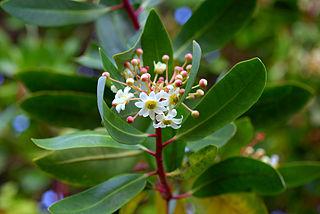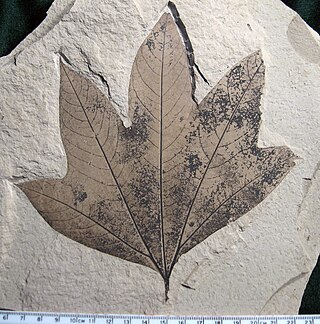
The Nymphaeales are an order of flowering plants, consisting of three families of aquatic plants, the Hydatellaceae, the Cabombaceae, and the Nymphaeaceae. It is one of the three orders of basal angiosperms, an early-diverging grade of flowering plants. At least 10 morphological characters unite the Nymphaeales. One of the traits is the absence of a vascular cambium, which is required to produce both xylem (wood) and phloem, which therefore are missing. Molecular synapomorphies are also known.

Amborella is a monotypic genus of understory shrubs or small trees endemic to the main island, Grande Terre, of New Caledonia in the southwest Pacific Ocean. The genus is the only member of the family Amborellaceae and the order Amborellales and contains a single species, Amborella trichopoda. Amborella is of great interest to plant systematists because molecular phylogenetic analyses consistently place it as the sister group to all other flowering plants.

Winteraceae is a primitive family of tropical trees and shrubs including 93 species in five genera. It is of particular interest because it is such a primitive angiosperm family, distantly related to Magnoliaceae, though it has a much more southern distribution. Plants in this family grow mostly in the southern hemisphere, and have been found in tropical to temperate climate regions of Malesia, Oceania, eastern Australia, New Zealand, Madagascar and the Neotropics, with most of the genera concentrated in Australasia and Malesia. The five genera, Takhtajania, Tasmannia, Drimys, Pseudowintera, and Zygogynum s.l. all have distinct geographic extant populations. Takhtajania includes a single species, T. perrieri, endemic only to Madagascar, Tasmannia has the largest distribution of genera in Winteraceae with species across the Philippines, Borneo, New Guinea, Eastern Australia, and Tasmannia, Drimys is found in the Neotropical realm, from southern Mexico to the subarctic forests of southern South America, Pseudowintera is found only in New Zealand, and Zygogynum has species in New Guinea and New Caledonia.

Plant reproductive morphology is the study of the physical form and structure of those parts of plants directly or indirectly concerned with sexual reproduction.
The Early Cretaceous or the Lower Cretaceous is the earlier or lower of the two major divisions of the Cretaceous. It is usually considered to stretch from 145 Ma to 100.5 Ma.

Bennettitales is an extinct order of seed plants that first appeared in the Permian period and became extinct in most areas toward the end of the Cretaceous. Bennettitales were amongst the most common seed plants of the Mesozoic, and had morphologies including shrub and cycad-like forms. The foliage of bennettitaleans is superficially nearly indistinguishable from that of cycads, but they are distinguished from cycads by their more complex flower-like reproductive organs, at least some of which were likely pollinated by insects.

Chloranthaceae is a family of flowering plants (angiosperms), the only family in the order Chloranthales. It is not closely related to any other family of flowering plants, and is among the early-diverging lineages in the angiosperms. They are woody or weakly woody plants occurring in Southeast Asia, the Pacific, Madagascar, Central and South America, and the West Indies. The family consists of four extant genera, totalling about 77 known species according to Christenhusz and Byng in 2016. Some species are used in traditional medicine. The type genus is Chloranthus. The fossil record of the family, mostly represented by pollen such as Clavatipollenites, extends back to the dawn of the history of flowering plants in the Early Cretaceous, and has been found on all continents.

Didymeles is a genus of flowering plants. It is variously treated as the only genus of the family Didymelaceae — or in the family Buxaceae, as in the APG IV system.
A strobilus is a structure present on many land plant species consisting of sporangia-bearing structures densely aggregated along a stem. Strobili are often called cones, but some botanists restrict the use of the term cone to the woody seed strobili of conifers. Strobili are characterized by a central axis surrounded by spirally arranged or decussate structures that may be modified leaves or modified stems.

Eosipterus is an extinct genus of ctenochasmatid pterosaur from the Early Cretaceous period of Liaoning, China. Fossil remains of Eosipterus dated back to the Aptian stage of the Early Cretaceous, 125 million years ago.

Haptanthus is a monotypic genus containing the sole species Haptanthus hazlettii, a shrub or small tree known only from the locality of Matarras in the Arizona Municipality in Honduras. Its flowers are unique among the flowering plants. A single "female" (carpellate) flower has two branches on either side which carry "male" (staminate) flowers. The flowers are very simple, lacking obvious sepals or petals. The family placement of the genus has been uncertain, but based on molecular phylogenetic research, it is included in the family Buxaceae as of September 2014. Very few individuals have ever been found and its habitat is threatened by logging.

Archaeamphora longicervia is a fossil plant species, the only member of the genus Archaeamphora. Fossil material assigned to this taxon originates from the Yixian Formation of northeastern China, dated to the Early Cretaceous.

The evolution of plants has resulted in a wide range of complexity, from the earliest algal mats, through multicellular marine and freshwater green algae, terrestrial bryophytes, lycopods and ferns, to the complex gymnosperms and angiosperms of today. While many of the earliest groups continue to thrive, as exemplified by red and green algae in marine environments, more recently derived groups have displaced previously ecologically dominant ones; for example, the ascendance of flowering plants over gymnosperms in terrestrial environments.
This page provides a glossary of plant morphology. Botanists and other biologists who study plant morphology use a number of different terms to classify and identify plant organs and parts that can be observed using no more than a handheld magnifying lens. This page provides help in understanding the numerous other pages describing plants by their various taxa. The accompanying page—Plant morphology—provides an overview of the science of the external form of plants. There is also an alphabetical list: Glossary of botanical terms. In contrast, this page deals with botanical terms in a systematic manner, with some illustrations, and organized by plant anatomy and function in plant physiology.

The Jehol Biota includes all the living organisms – the ecosystem – of northeastern China between 133 and 120 million years ago. This is the Lower Cretaceous ecosystem which left fossils in the Yixian Formation and Jiufotang Formation. These deposits are composed of layers of tephra and sediment. It is also believed to have left fossils in the Sinuiju series of North Korea. The ecosystem in the Lower Cretaceous was dominated by wetlands and numerous lakes. Rainfall was seasonal, alternating between semiarid and mesic conditions. The climate was temperate. The Jehol ecosystem was interrupted periodically by ash eruptions from volcanoes to the west. The word "Jehol" is a historical transcription of the former Rehe Province.

Calamoideae is a subfamily of flowering plant in the palm family found throughout Central America, South America, Africa, India, China, Southeast Asia and Australia. It is represented by 21 genera - containing nearly a quarter of all species in the palm family - including the largest genus, Calamus, the type genus of the group. Only four are found in the New World while the rest are Old World denizens, usually found in equatorial swampland or along tropical coastlines.

Macginitiea is an extinct genus in the family Platanaceae ranging from the Late Paleocene to Late Eocene of North America, known from the Clarno Formation of central Oregon. The genus is strictly used to describe leaves, but has been found in close association with other fossil platanoid organs, which collectively have been used for whole plant reconstructions. Macginitiea and its associated organs are important as together they comprise one of the most well-documented and ubiquitous fossil plants, particularly in the Paleogene of North America.
Nanjinganthus dendrostyla is a fossil plant known from Early Jurassic sediments in China and proposed by Fu, et al. to represent a pre-Cretaceous angiosperm. The material consists of numerous compression fossils which bear a resemblance to flowers. The segments bear prominent ridges, suggesting veins, and a few specimens have a branched axis perpendicular to the segments, interpreted by Fu, et al. as a branched style. Beneath the putative perianth, Fu, et al. interpret the existence of ovules enclosed in ovaries, however, the preservation of this region of the structure is poor.
This paleobotany list records new fossil plant taxa that were to be described during the year 2022, as well as notes other significant paleobotany discoveries and events which occurred during 2022.
The fossil history of flowering plants records the development of flowers and other distinctive structures of the angiosperms, now the dominant group of plants on land. The history is controversial as flowering plants appear in great diversity in the Cretaceous, with scanty and debatable records before that, creating a puzzle for evolutionary biologists that Charles Darwin named an "abominable mystery".














